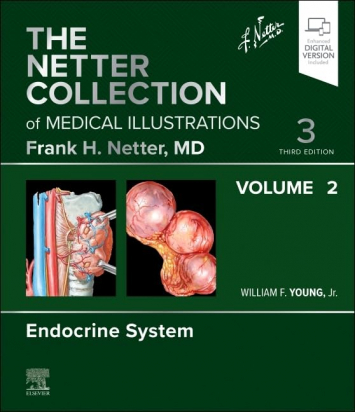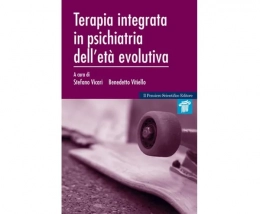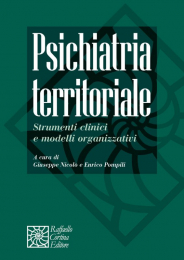Non ci sono recensioni
DA SCONTARE
| Description: Offering a concise, highly visual approach to the basic science and clinical pathology of the endocrine system, this updated volume in The Netter Collection of Medical Illustrations (the CIBA "Green Books") contains unparalleled didactic illustrations reflecting the latest medical knowledge. Revised by Dr. William F. Young, Jr., Endocrine System, Volume 2 integrates core concepts of anatomy, embryology, physiology, and genetics with common clinical correlates across health, medical, and surgical disciplines. Classic Netter art, updated and new illustrations, and modern imaging continue to bring medical concepts to life and make this timeless work an essential resource for students, clinicians, and educators. |
| Features: |
|
SECTION 1 PITUITARY AND HYPOTHALAMUS
1.1 Development of the Pituitary Gland
1.2 Divisions of the Pituitary Gland and Relationship to the Hypothalamus
1.3 Blood Supply of the Pituitary Gland
1.4 Anatomy and Relationships of the Pituitary Gland
1.5 Relationship of the Pituitary Gland to the Cavernous Sinus
1.6 Relationships of the Sella Turcica
1.7 Anterior Pituitary Hormones and Feedback Control
1.8 Posterior Pituitary Gland
1.9 Manifestations of Suprasellar Disease
1.10 Craniopharyngioma
1.11 Effects of Pituitary Tumors on the Visual Apparatus
1.12 Nontumorous Lesions of the Pituitary Gland
1.13 Pituitary Anterior Lobe Deficiency in Childhood and Adolescence in Boys
1.14 Pituitary Anterior Lobe Deficiency in Adults
1.15 Selective and Partial Hypopituitarism
1.16 Severe Anterior Pituitary Deficiency or Panhypopituitarism
1.17 Postpartum Pituitary Infarction (Sheehan Syndrome)
1.18 Pituitary Apoplexy
1.19 Pituitary Gigantism
1.20 Acromegaly
1.21 Prolactin-Secreting Pituitary Tumor
1.22 Corticotropin-Secreting Pituitary Tumor
1.23 Nelson Syndrome
1.24 Clinically Nonfunctioning Pituitary Tumor
1.25 Secretion and Action of Oxytocin
1.26 Secretion and Action of Vasopressin
1.27 Central Diabetes Insipidus (Arginine Vasopressin Deficiency)
1.28 Langerhans Cell Histiocytosis in Children
1.29 Langerhans Cell Histiocytosis in Adults
1.30 Pituitary Stalk Lesions
1.31 Empty Sella
1.32 Tumors Metastatic to the Pituitary
1.33 Surgical Approaches to the Pituitary
SECTION 2 THYROID
2.1 Anatomy of the Thyroid and Parathyroid Glands
2.2 Anatomy of the Thyroid and Parathyroid Glands (Continued)
2.3 Development of the Thyroid and Parathyroid Glands
2.4 Development of the Thyroid and Parathyroid Glands (Continued)
2.5 Congenital Anomalies of the Thyroid Gland
2.6 Effects of Thyrotropin on the Thyroid Gland
2.7 Physiology of Thyroid Hormones
2.8 Graves Disease
2.9 Graves Disease (Continued)
2.10 Graves Ophthalmopathy
2.11 Thyroid Pathology in Graves Disease
2.12 Clinical Manifestations of Toxic Adenoma and Toxic Multinodular Goiter
2.13 Pathophysiology of Toxic Adenoma and Toxic Multinodular Goiter
2.14 Clinical Manifestations of Hypothyroidism in Adults
2.15 Clinical Manifestations of Hypothyroidism in Adults (Continued)
2.16 Clinical Manifestations of Hypothyroidism in Adults (Continued)
2.17 Congenital Hypothyroidism
2.18 Euthyroid Goiter
2.19 Gross Pathology of Goiter
2.20 Etiology of Nontoxic Goiter
2.21 Chronic Lymphocytic Thyroiditis and Fibrous Thyroiditis
2.22 Subacute Thyroiditis
2.23 Papillary Thyroid Carcinoma
2.24 Follicular Thyroid Carcinoma
2.25 Medullary Thyroid Carcinoma
2.26 Oncocytic (Hürthle Cell) Thyroid Carcinoma
2.27 Anaplastic Thyroid Carcinoma
2.28 Thyroid Biopsy
2.29 Tumors Metastatic to the Thyroid
SECTION 3 ADRENAL
3.1 Development of the Adrenal Glands
3.2 Anatomy and Blood Supply of the Adrenal Glands
3.3 Anatomy and Blood Supply of the Adrenal Glands (Continued)
3.4 Innervation of the Adrenal Glands
3.5 Histology of the Adrenal Glands
3.6 Biosynthesis and Metabolism of Adrenal Cortical Hormones
3.7 Biosynthesis and Metabolism of Adrenal Cortical Hormones (Continued)
3.8 Biologic Actions of Cortisol
3.9 Cushing Syndrome: Clinical Findings
3.10 Tests Used in the Diagnosis of Cushing Syndrome
3.11 Cushing Syndrome: Pathophysiology
3.12 Carney Complex: Cushing Syndrome Caused by Primary Pigmented Nodular Adrenocortical Disease
3.13 Major Blocks in Abnormal Steroidogenesis
3.14 Classic Congenital Adrenal Hyperplasia
3.15 Biologic Actions of Adrenal Androgens
3.16 Adult Androgenital Syndromes
3.17 Biologic Actions of Aldosterone
3.18 Primary Aldosteronism
3.19 Adrenal Venous Sampling for Primary Aldosteronism
3.20 Renin-Angiotensin-Aldosterone System and Renovascular Hypertension
3.21 Acute Adrenal Failure: Adrenal Crisis
3.22 Chronic Primary Adrenal Failure: Addison Disease
3.23 Laboratory Findings and Treatment of Primary drenal Insufficiency
3.24 Laboratory Findings and Treatment of Secondary Adrenal Insufficiency
3.25 Adrenal Medulla and Catecholamines
3.26 Catecholamine Synthesis, Storage, Secretion, Metabolism, and Inactivation
3.27 Pheochromocytoma and Paraganglioma
3.28 Pheochromocytoma and Paraganglioma (Continued)
3.29 Metastatic Pheochromocytoma and Paraganglioma
3.30 Adrenocortical Carcinoma
3.31 Tumors Metastatic to the Adrenal Glands
SECTION 4 REPRODUCTION
4.1 Differentiation of Gonads
4.2 Differentiation of Genital Ducts
4.3 Differentiation of External Genitalia
4.4 Testosterone and Estrogen Synthesis
4.5 Normal Puberty
4.6 Normal Puberty (Continued)
4.7 Normal Puberty (Continued)
4.8 Normal Puberty (Continued)
4.9 Precocious Puberty
4.10 Precocious Puberty (Continued)
4.11 Precocious Puberty (Continued)
4.12 Disorders of Sex Development
4.13 Disorders of Sex Development (Continued)
4.14 Disorders of Sex Development (Continued)
4.15 Disorders of Sex Development (Continued)
4.16 Errors in Chromosomal Sex
4.17 Klinefelter Syndrome
4.18 Turner Syndrome (Gonadal Dysgenesis)
4.19 Turner Syndrome (Gonadal Dysgenesis) (Continued)
4.20 Turner Syndrome (Gonadal Dysgenesis) (Continued)
4.21 Hirsutism and Virilization
4.22 Hirsutism and Virilization (Continued)
4.23 Influence of Gonadal Hormones on the Female Reproductive Cycle From Birth to Old Age
4.24 Functional and Pathologic Causes of Uterine Bleeding
4.25 Gynecomastia
4.26 Galactorrhea
SECTION 5 PANCREAS
5.1 Pancreas Anatomy and Histology
5.2 Exocrine Functions of the Pancreas
5.3 Normal Histology of Pancreatic Islets
5.4 Insulin Secretion
5.5 Actions of Insulin
5.6 Glycolysis
5.7 Tricarboxylic Acid Cycle
5.8 Glycogen Metabolism
5.9 Consequences of Insulin Deprivation
5.10 Diabetic Ketoacidosis
5.11 Type 1 Diabetes Mellitus
5.12 Type 2 Diabetes Mellitus
5.13 Diabetic Retinopathy
5.14 Complications of Proliferative Diabetic Retinopathy
5.15 Diabetic Nephropathy
5.16 Diabetic Neuropathy
5.17 Atherosclerosis in Diabetes
5.18 Diabetes-Related Dermatologic Manifestations
5.19 Vascular Insufficiency in Diabetes: The Diabetic Foot
5.20 Diabetes Mellitus in Pregnancy
5.21 Treatment of Type 2 Diabetes Mellitus
5.22 Intensive Diabetes Therapy of Type 1 Diabetes Mellitus
5.23 Insulinoma
5.24 Primary Pancreatic b-Cell Hyperplasia
SECTION 6 BONE AND CALCIUM
6.1 Histology of the Normal Parathyroid Glands
6.2 Physiology of the Parathyroid Glands
6.3 Bone Remodeling Unit
6.4 Pathophysiology of Primary Hyperparathyroidism
6.5 Pathology and Clinical Manifestations of Primary Hyperparathyroidism
6.6 Tests for the Differential Diagnosis of the Causes of Hypercalcemia
6.7 Renal Osteodystrophy
6.8 Renal Osteodystrophy (Continued)
6.9 Histology of the Parathyroid Glands in Hyperparathyroidism
6.10 Pathophysiology of Hypoparathyroidism
6.11 Clinical Manifestations of Acute Hypocalcemia
6.12 Pathophysiology of Pseudohypoparathyroidism
6.13 Clinical Manifestations of Pseudohypoparathyroidism Type 1a
6.14 Pathogenesis of Osteoporosis
6.15 Osteoporosis in Postmenopausal Females
6.16 Osteoporosis in Males
6.17 Clinical Manifestations of Osteoporotic Vertebral Compression Fractures
6.18 Nutritional-Deficiency Rickets and Osteomalacia
6.19 Pseudovitamin D–Deficient Rickets and Osteomalacia
6.20 Hypophosphatemic Rickets
6.21 Clinical Manifestations of Rickets in Childhood
6.22 Clinical Manifestations of Osteomalacia in Adults
6.23 Paget Disease of the Bone
6.24 Pathogenesis and Treatment of Paget Disease of the Bone
6.25 Osteogenesis Imperfecta
6.26 Osteogenesis Imperfecta (Continued)
6.27 Hypophosphatasia
SECTION 7 LIPIDS AND NUTRITION
7.1 Cholesterol Synthesis and Metabolism
7.2 Gastrointestinal Absorption of Cholesterol and Triglycerides
7.3 Regulation of Low-Density Lipoprotein Receptor and Cholesterol Content
7.4 High-Density Lipoprotein Metabolism and Reverse Cholesterol Transport
7.5 Hypercholesterolemia
7.6 Hypercholesterolemic Xanthomatosis
7.7 Hypercholesterolemic Xanthomatosis (Continued)
7.8 Abetalipoproteinemia and Tangier Disease
7.9 Hypertriglyceridemia
7.10 Clinical Manifestations of Hypertriglyceridemia
7.11 Clinical Manifestations of Hypertriglyceridemia (Continued)
7.12 Atherosclerosis
7.13 Atherosclerosis (Continued)
7.14 Atherosclerosis Risk Factors
7.15 Metabolic Syndrome
7.16 Mechanisms of Action of Lipid-Lowering Agents
7.17 Treatment of Hyperlipidemia
7.18 Absorption of Essential Vitamins
7.19 Vitamin B1 Deficiency: Beriberi
7.20 Vitamin B3 Deficiency: Pellagra
7.21 Vitamin C Deficiency: Scurvy
7.22 Vitamin A Deficiency
7.23 Celiac Disease and Malabsorption
7.24 Lysosomal Storage Disorders: Sphingolipidoses
7.24 Lysosomal Storage Disorders: Sphingolipidoses (Continued)
7.25 Anorexia Nervosa
7.26 Obesity
7.27 Surgical Treatment Options for Obesity
SECTION 8 GENETICS AND ENDOCRINE NEOPLASIA
8.1 Multiple Endocrine Neoplasia Type 1
8.2 Multiple Endocrine Neoplasia Type 2
8.3 Multiple Endocrine Neoplasia Type 2 (Continued)
8.4 Von Hippel-Lindau Syndrome
8.5 Neurofibromatosis Type 1 (von Recklinghausen Disease)
8.6 Clinical Manifestations of Autoimmune Polyglandular Syndrome Type 1
8.7 Carcinoid Syndrome
8.8 McCune-Albright Syndrome
8.9 Carney Triad
Glossary of Abbreviations
Selected References
Index




